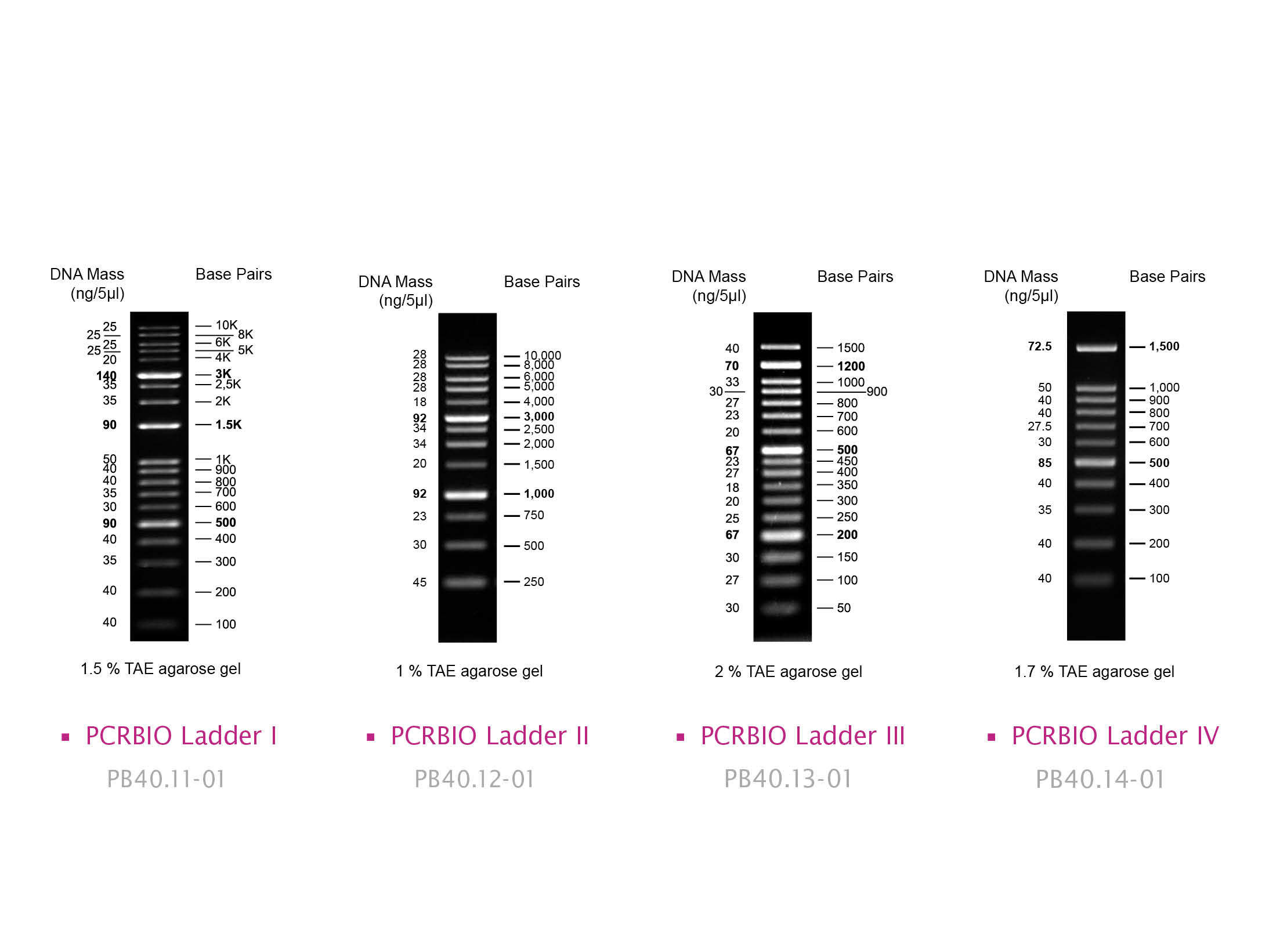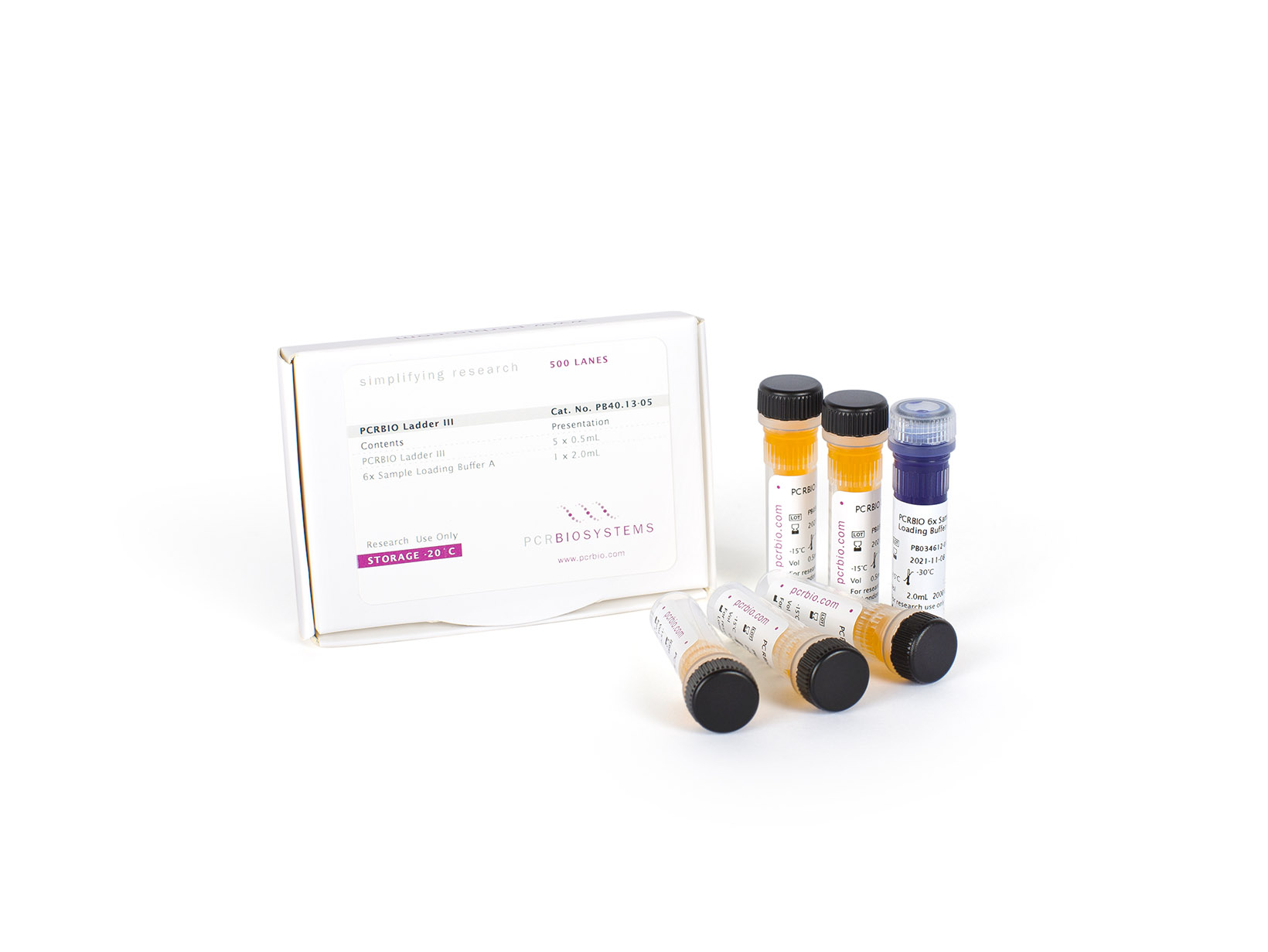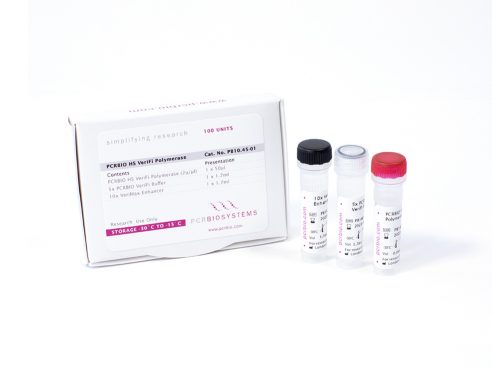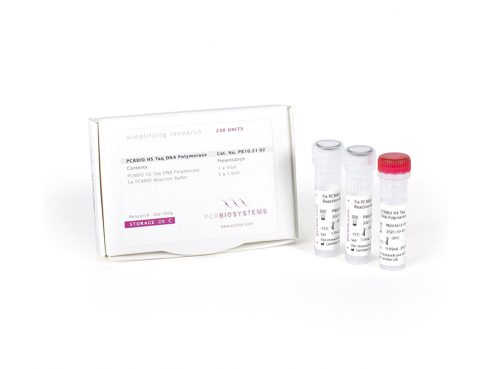To view your price please login or contact us
PCRBIO DNA Markers
PCRBIO Ladders I-IV are designed for easy size determination and DNA quantification using agarose gel electrophoresis.
The ladders are room temperature stable and ready for immediate gel loading. They cover a wide range (from 50bp to 10kb) and contain loading dye for simple migration observation.
Features
- Ready to use – load straight onto your gel
- Room temperature stable – store at 25°C
- Quantitative – helps to visualise PCR yield
- Wide range – 50bp to 10kb
- Evenly spaced bands
- Easy to identify reference bands
More Information
PCRBIO Ladders I-IV are manufactured using a combination of plasmid restriction digest fragments and PCR amplification products. The ladders are resuspended in sample buffer ready for immediate gel loading. The buffer formulation also allows for greater room temperature stability compared to conventional DNA ladders.
Applications
- Agarose gel electrophoresis
Specifications
PCRBIO Ladder I - IV
Component
100 Lanes
500 Lanes
PCRBIO Ladder
1 x 500 μL
5 x 500 μL
6x Sample Loading Buffer A
1 x 400 μL
1 x 2 mL
PCRBIO Ladder I - IV
Component
PCRBIO Ladder
6x Sample Loading Buffer A
100 Lanes
1 x 500 μL
1 x 400 μL
500 Lanes
5 x 500 μL
1 x 2 mL
Reaction Volume
Storage
Not applicable
Store at 25 °C for 6 months
Store at 4 °C for 12 months
Store between -30 °C and -15 °C for 24 months
Reaction Volume
Not applicable
Storage
Store at 25 °C for 6 months
Store at 4 °C for 12 months
Store between -30 °C and -15 °C for 24 months
Documents
Product Flyers
Product Manuals
Material Safety Data Sheets
Certificate of Analysis Finder
FAQs
Are PCRBIO Ladders stable at room temperature?
The ladders are already suspended in sample buffer and are ready for gel loading. The buffer formulation also allows for greater room temperature stability compared to conventional DNA ladders. Our ladders match or exceed stability of the best on the market.
What are the recommended applications for PCRBIO Ladders?
PCRBIO Ladders are designed for size determination and DNA quantification using agarose electrophoresis.
What are the sizes of PCRBIO ladders?
PCRBIO Ladder I (PB40.11): 100 – 10,000 bp
PCRBIO Ladder II (PB40.12): 250 – 10,000 bp
PCRBIO Ladder III (PB40.13): 50 – 1,500 bp
PCRBIO Ladder IV (PB40.14): 100 – 1,500 bp
Why do PCRBIO Ladders appear diffused on E-Gel Precast Agarose Electrophoresis System and how can I fix this?
The precast agarose systems are convenient however, there is a degree of compromise on the resolution. Any ladders will appear at much lower resolution on these systems. This is mainly due to the limited control they allow over the voltage as well as the gels themselves. A partial fix is to load less and ensure the ladder runs as far as it can. If the quality is still insufficient, we recommend using more traditional tanks and freshly cast gels.
More Information
PCRBIO Ladders I-IV are manufactured using a combination of plasmid restriction digest fragments and PCR amplification products. The ladders are resuspended in sample buffer ready for immediate gel loading. The buffer formulation also allows for greater room temperature stability compared to conventional DNA ladders.
Applications
- Agarose gel electrophoresis
Specifications
PCRBIO Ladder I - IV
Component
100 Lanes
500 Lanes
PCRBIO Ladder
1 x 500 μL
5 x 500 μL
6x Sample Loading Buffer A
1 x 400 μL
1 x 2 mL
PCRBIO Ladder I - IV
Component
PCRBIO Ladder
6x Sample Loading Buffer A
100 Lanes
1 x 500 μL
1 x 400 μL
500 Lanes
5 x 500 μL
1 x 2 mL
Reaction Volume
Storage
Not applicable
Store at 25 °C for 6 months
Store at 4 °C for 12 months
Store between -30 °C and -15 °C for 24 months
Reaction Volume
Not applicable
Storage
Store at 25 °C for 6 months
Store at 4 °C for 12 months
Store between -30 °C and -15 °C for 24 months
Documents
Product Flyers
Product Manuals
Material Safety Data Sheets
Certificate of Analysis Finder
FAQs
Are PCRBIO Ladders stable at room temperature?
The ladders are already suspended in sample buffer and are ready for gel loading. The buffer formulation also allows for greater room temperature stability compared to conventional DNA ladders. Our ladders match or exceed stability of the best on the market.
What are the recommended applications for PCRBIO Ladders?
PCRBIO Ladders are designed for size determination and DNA quantification using agarose electrophoresis.
What are the sizes of PCRBIO ladders?
PCRBIO Ladder I (PB40.11): 100 – 10,000 bp
PCRBIO Ladder II (PB40.12): 250 – 10,000 bp
PCRBIO Ladder III (PB40.13): 50 – 1,500 bp
PCRBIO Ladder IV (PB40.14): 100 – 1,500 bp
Why do PCRBIO Ladders appear diffused on E-Gel Precast Agarose Electrophoresis System and how can I fix this?
The precast agarose systems are convenient however, there is a degree of compromise on the resolution. Any ladders will appear at much lower resolution on these systems. This is mainly due to the limited control they allow over the voltage as well as the gels themselves. A partial fix is to load less and ensure the ladder runs as far as it can. If the quality is still insufficient, we recommend using more traditional tanks and freshly cast gels.












